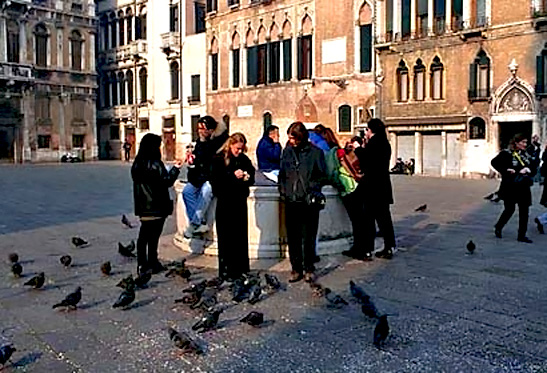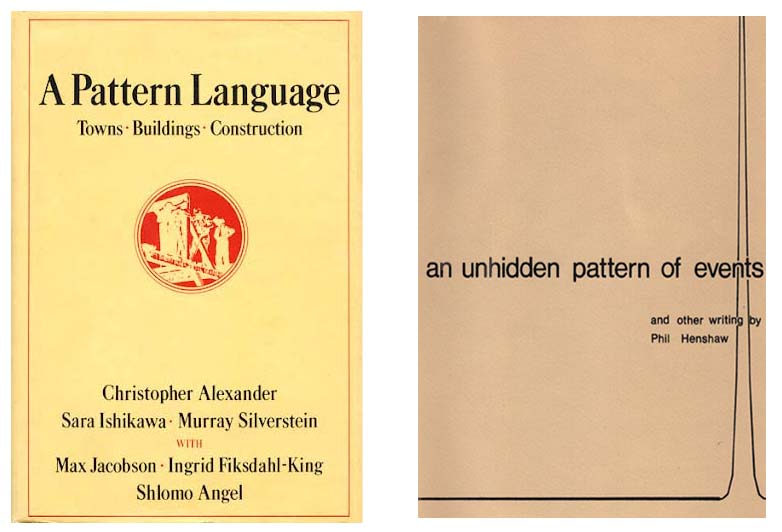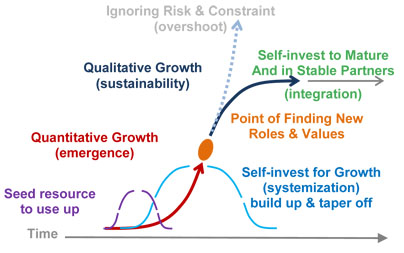Our oil addiction, like all addictions, became a physical trap, and shaped our ways of life to fit its temporary needs.
Needing to consume ever more of the remaining affordable oil supplies also has pollution effects that will permanently disrupt the earth’s climate.
We do it to achieve an evidently false image of “economic stability”.
The design of our environment, our spaces and uses, will change adaptively as some parts of what we built find new lasting uses and others don’t. Christopher Alexander is an architect whose “Pattern Language” explores how the natural processes of reshaping the spaces we live in over time has created urban spaces perfectly fitting their use as a form of natural environmental design.

One can discover how we fell into the trap of dependence on an ever growing use of oil with no future. That won’t quickly change the world we built around it though. As we respond, the natural forces and our responsive thinking will reshape our space, likely leading us to follow nature’s paths to finding opportunity and harmony.
My “Unhidden Pattern of Events” and the “Physics of Happening” that followed from it also stemmed from my observations as an architect of the naturally evolving designs of environmental systems. My subjects started with studying the progression from simple to complex observed in design projects, starting with a “seed idea”, and of air currents, starting with a “seed of motion”, that then released growing then declining amounts of energy on its path to completion.
Both then, search for deep meaning in “the conversation” that occurs, back and forth, between natural systems of development and their environments, as they change each other.

How highly complex environmental designs emerge with independently changing parts can be thought of as like the parts looking for the most profitable way to fit in and avoid conflict. For the oil trap it’s a question of searching for a profitable way to avoid conflict when the environmental signal is of critical resources approaching real dead end.
The real escape is only by studying and acknowledging the reality and exploring what else we might be misunderstanding so we would become capable of choosing a path that allows us to yield to the real world, rather than die fighting it in some foolish last stand.
Perhaps combining my approach with Christopher Alexander’s complementary method will give people the practical technique to do it.
The easily observable part of how we got trapped by cheap energy is that the cost of using more oil had been continually declining for decades, as people invented more efficient ways to use it and discovered larger pools of energy resources. Then the cost curve reversed directions, though, as growing use led to the natural development of growing complications rather than unfettered opportunities as it seemed to produce at first.
Every impact of humans on the earth, not only energy scarcity and climate change, are direct results of our ever growing energy use.
People thought if they didn’t know why it was occurring, our impacts and the complications of ever growing energy use might go away. They didn’t. The more important thing, though, is understanding why they naturally didn’t.
This very same reversal in the cost curve for any growth process, using any kind of resource, is a universal natural phenomenon that occurs for every kind of growth system as it approaches its own particular limit. The whole system response is initially hidden, though, and generally depends on being inquisitive and finding new things to measure the costs of to see it.
Our confusion about how to respond was not actually caused by people not seeing it happening, nor by failing to anticipate it coming is the more curious part. Lots of people both saw it coming and happening.
The trap for us seems to have been letting our emotions control our responses, as for any addiction that people suffer from, and clinging to our energy attachment even as great harm was clearly being done. The important step to changing that is to start observing what’s happening, and how very smoothly responsive growth processes adapt to their own natural limits, and asking why we didn’t think of that.
So the real solution is realizing that whenever people let wishful thinking become an emotional trap, to salvage things we need to respond by finding new meaning in nature’s signals.
That quest to find new meaning needs to be partly done using the same dangerous creative talents that led us into our addiction (but doing it right this time). Our creative talents have great power to expand opportunity for satisfying our various emotional purposes.
This time we need to find common purposes with our living world, and measure success with their response not our emotional feelings about it. That our whole society came to believe we could remove all natural obstacles to our desires is another sign of the trap that makes us unable to respond to our changing physical world.
That life becomes a matter of responding to your world, not controlling it, is ironically the very same simple fact of life that people in less loaded circumstances comfortably and creatively find such a rewarding part of life. How natural systems exhibit responsiveness to each other is the true dance of life, really.
That’s the true lesson and learning opportunity, turning what looks like a dead end into an invitation to respond to new dance partners, actually. It rather changes the nature of the trap we are in, that perpetuating the problem isn’t the solution, but realizing it’s the signal to find meaning in other things and that is what naturally leads finding them.
We let our emotions control what physical realities to respond to, and aren’t listening to nature’s call for response.
I recently came across the possibility of a good fit between Christopher Alexander’s work and mine from discovering a link between what seems to be his new focus, and the central theme of my years of work. Both describe how people can learn fromobserving the responsive process of accumulation that is visible in all of nature’s complex design processes.
Alexander and I are both architects and naturalists. We both noticed a range of features of natural organization and write on ways of observing and learning from them. The essential observation seems to be that natural systems of local relationships develop from local processes that stimulate environmental responses, and then together accumulate a history of inventive responses to each other.
That’s all it is, and you could write that in on the quiz and be done with it, unless you were curious to discover how such a very simple formula, so readily observed, could possibly work in so many kinds of circumstances, and not have been noticed for so long. I call the process of growth that develops systems of relationships an “organizational learning process“, and use the physics of energy system development to interpret recorded physical measures of change and observations to help identify what responses are working and what to think of experimenting with for those that increasingly are not.
Alexander calls it “harmony-seeking computation” and uses a different but related classification of holistic categories to discover narratives of accumulative self-organization in spatial environments. He uses a syntax of shape and symmetry transformation, and I use the cypher of flowing successions of different kinds of change from beginning to ending (¸¸.•´ ¯ `•.¸¸) with each of us speaking in different ways about the same thing.
In Alexander’s 80 page “Harmony-seeking computations: a science of Non-Classical Dynamics based on the Progressive Evolution of the Larger Whole” contains lots of things to read careful, and think about. It’s somewhat difficult reading like my writing on the subject because it is asking the reader to think about their own original observations and learning about how things fit together in nature.
We have access to how nature works only by recognizing some of its patterns, but the subject is inherently “unfamiliar” in that it is not about our own cultural values but of the values expressed by the “alien” units of organization in our natural world. [see also his shorter Version 20 (66 pages) and his “Nature of Order” book and other work]
Another reason to read patiently and with care is that he, as I, draw on a lifetime of close observation of natural form, and are writing with a hope that a reader has done enough observation themselves to recognize the subjects being discussed. Partly one should also be careful because every observer of complex systems will understand some parts better than others, and not always tell you which is which.
I think in some ways, because it’s my focus and not his, that I have a clearer idea of a rigorous science molded to fit the form of how natural systems develop and behave. He appears to understands much better than I the process of harmony-seeking processes for habitations and built forms. Part of what I get for being more focused on the rigorous science, though, is no audience…!
So the potential of a complementary match for those needs, as well as the reinforcement of both studying the same natural process from different sides and linking separate discoveries, are the significant values offered for finding how they can fit together.
So I don’t mind if reading his very appealing way of thinking about it involves stretching some of the meanings of his words to fit the physical reality, as I see it or as anyone else does. That’s kind of unavoidable for studying my work too, as the subjects of both are complex relationships that fit somewhat different description in each circumstance, and individuals will always somewhat differently understand the underlying principles of nature. They’re “explanatory principles” not “laws of nature”, very useful for discovering one’s own environment by recognition of the universal patterns found.
each person stretches some of the meanings of the words to fit their understanding of the physical reality
The main shift in the normal meaning of his terms I’d take pains to point to is the much richer meaning he uses for the word “computation” than most people would understand. For him it is not the calculation of a pre-determined answer from a pre-existing equation, but the ‘calculation’ of changing ‘equations’ as they responsively fit themselves together.
Of course, mathematical equations simply don’t work if their parts include instructions like “read the environment here”. That equations can’t do that is one of the obvious facts that, for emotional reasons, modern science has generally tried to ignore as best it could. The primary tool we use for representing nature just doesn’t work well for emulating natural design.
That modern science, so far, has almost exclusively studied and represented nature as following deterministic equations may be the biggest emotional hurdle of all for learning to escape the physical trap mankind has built for itself. The basic limitation is that equations can’t operate without being defined, and so can’t responsively change their own definitions.
They also don’t have environments to respond to anyway, and wouldn’t have a way to read other languages for defining things either. So, equations are limited for emulating nature on several counts. It’s people who need to fill in the missing roles for our equations but science has taught us not to do that, to develop equations that then let us ignore what new things are going on to respond to.
This additional major unresponsiveness of human thinking to nature, is another missed signal from nature. Like other missed signals it can become a very rich source of the new meaning for leading us out of our trap, and away from our oil addiction and other things. Architecture is practical art and natural philosophy, and inherently a responsive learning process. The test is always whether a design thrives on its own, not whether a design satisfies the designer’s own ideology.
How I first discussed the natural design process was as “An Unhidden Pattern of Events” that I discovered in studying the evolution of air currents. Things may all decline, but have to develop first, is one way to say it. A few years later I wrote “Directed Opportunity, Directed Impetus: New tools for investigating autonomous causation” which focuses on spatial “harmony-seeking” process in somewhat the same way Alexander now does, as an accumulation of mutual internal and external responses.
The most common data showing graphically showing the process are the deceptively simple shapes of change in measures of growth in energy using processes. They generally start from very small beginnings, often too small to measure, with a seed of organization taking growing control of its momentarily limitless resources.
That growth by self-imitation expands until switching to growth that is more responsive to the shapes of its environment than to itself. It’s “two step” process of building environmental systems that become integrated wholes. In ecologies it may occur repeatedly, starting with prototype seeds of “internal” systems of relationships that expand to involve “external” ones in achieving a sustainable new level of whole environmental organization.
That typical process of inventing lasting environmental change is what one commonly finds behind the ubiquitous “S” curves of successful learning and development processes. They all require building systems of energy use in the process, first with successively larger steps of self-centered addition followed by successively smaller steps while maturing and developing new roles in a wider environment.
It’s mostly living systems or systems with living parts that respond to limits to their growth creatively to become sustainable by doing so. There are also lots non-living systems that stabilize for extended periods too, providing simpler examples.
A candle for example starts its energy using process by starting small and briefly growing exponentially, but then the flame gets big enough it rises where it can’t heat more fuel, so the candle burns steadily, and so last a far longer time than its growth period.
The mathematical difference is evident at the first inflection point in a system’s developmental history curve. That is the point where new internal or external environmental influences are emerging and the cost curve for self-expanding replication switches sign.
That point is also the peak of the mathematical derivative of the curve, and the shape of the derivative will often show if the turn is toward stability or directly to collapse. If difference is between growth systems that will fall from their peak and decay as quickly as they developed, and those that stabilize at the peak of their development.
What grows into life is a multiplication from an initial seed of organization reproducing itself, that becomes sustained by filling a new role in its environment. Its the kind of growth from a seed that flexibly responds to becoming part of the complex world it naturally finds, as its opportunity for quantitative self-expansion leads to discovering a much larger universe of active qualitative relationships.
part ed: 2/21/12

